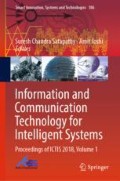Abstract
Emotion is a state of mind affected by many external parameters one of which is text either read or spoken by others or self. Recognition of emotion from facial expression, sound intensity, or text is becoming an interesting research area. Extracting emotions from text is quite unfocused but important research problem from natural language processing domain. It requires the construction of emotional lexicon in respective natural language for classification of text/document into emotional classes. In this paper, an overview of the state-of-the-art techniques used to construct emotional lexicon for different languages is given. These methods are in their initial stage of research as much of the work is conducted for optimizing the results and hence open to wide field of innovative contributions. The author concludes with a proposal for developing language independent emotional lexicon. Main challenges in implementing this are discussed and promising applications in various fields are also elaborated.
Access this chapter
Tax calculation will be finalised at checkout
Purchases are for personal use only
References
Patra, B.G., Das, D., Bandyopadhyay, S.: Automatic music mood classification of Hindi songs. In: Proceedings of the 3rd Workshop on Sentiment Analysis where AI meets Psychology (SAAIP 2013), IJCNLP 2013, pp. 24–28, Nagoya, Japan, 14 October 2013
Patra, B.G., Bandyopadhyay, S.: Mood classification of Hindi Songs based on lyrics
Alsharif, Q., Alshamaa, D., Ghneim, N.: Emotion Classification in Arabic Poery using Machine Learning
Chuang, Z.-J., Chung-Hsien, W.: Multi-modal emotion recognition from speech and text. Comput. Linguist. Chin. Language Process. 9(2), 45–62 (2004)
Patel, S.N., Choksi, J.B.: A survey of sentiment classification techniques. J. Res. 01(01) (2015). ISSN: 2395-7549
Das, A., Bandyopadhyay, S.: SentiWordNet for Indian languages. In: Proceedings of the 8th Workshop on Asian Language Resources, pp. 56–63, Beijing, China, 21–22 August 2010
Calvo, R.A., D’Mello, S.: Affect detection: an interdisciplinary review of models, methods and their applications. IEEE Tran. Affect. Comput. 1(1) (2010)
Quan, C., Ren, F.: Construction of blog emotion corpus for chinese emotional expression analysis. In: Proceedings of the 2009 Conference on Empirical Methods in Natural Language Processing, pp. 1446–1454, Singapore, 6–7 August 2009
Das, D., Bndyopadhyay, S.: Labeling emotion in Bengali Corpus-A fine grained tagging at sentence level. In: Proceedings of the 8th Workshop on Asian Language Resources, pp. 47–55, Beijing, China, 21–22 August 2010
Balmurli, A.R., Joshi, A., Bhattacharyya, P.: Cost and benefit of using WordNet senses for sentiment analysis
Strapparava, C., Valitutti, A.: WordNet affect: an affective extension of WordNet. In: Language Resources and Evaluation (2004)
Xu, G., Meng, X., Wang, H.: Build Chinese emotion lexicons using a graph-based algorithm and multiple resources. In: Proceedings of the 23rd International Conference on Computational Linguistics (Coling 2010), pp. 1209–1217, Beijing, August 2010
Mohammad, S.M., Turney, P.D.: Emotions evoked by common words and phrases: using mechanical turk to create an emotion lexicon. In: Proceedings of the NAACL HLT 2010 Workshop on Computational Approaches to Analysis and Generation of Emotion in Text, pp. 26–34, Los Angeles, California, June 2010. ©2010. Association for Computational Linguistics
Mohammad, S.M., Turney, P.D.: Crowdsourcing a word-emotion association lexicon. In: National Research Council Canada, arXiv:1308.6297vi [cs.CL]. 28 Aug 2013
Das, D., Poriam S., Bandyopadhyay, S.: A Classifier based approach to emotion Lexicon construction. In: Bouma, G., Ittoo, A., Metais, E., Wortmann, H. (eds) Natural Language Processing and Information Systems. NLDB 2012 Lecture Notes in Computer Science, vol. 7337. Springer, Berlin, Heidelberg (2012)
Patra, B.G., Takamura, H., Das, D., Okumura, M., Bandyopadhyay, S.: Construction of emotional lexicon using potts model. In: International Joint Conference on Natural Language Processing, pp. 674–679, Nagoya, Japan, 14–18 October 2013
Poria, S., Gelbukh, A., Das, D., Bandyopadhyay, S.: Fuzzy clustering for semi-supervised learning-case study: construction of an emotion Lexicon. In: Batyrshin, I., Gonzalez Mendoza, M. (eds) Advances in Artificial Intelligence. MICAI 2012. Lecture Notes in Computer Science, vol. 7629. Springer, Berlin, Heidelberg (2013)
Brenga, C., Celotto, A., Loia, V., Senatore, S.: Fuzzy linguistic aggregation to synthesize the hourglass of emotions. In: 2015 IEEE International Conference Fuzzy Systems (FUZZ-IEEE). https://doi.org/10.1109/fuzz-ieee.2015.7338020
Torii, Y., Das, D., Bandyopadhyay, S., Okumura1, M.: Developing Japanese WordNet affect for analyzing emotions. In: Proceedings of the 2nd Workshop on Computational Approaches to Subjectivity and Sentiment Analysis, ACL-HLT 2011, pp. 80–86, 24 June 2011, Portland, Oregon, USA (2011). Association for Computational Linguistics
Abdaoui, A., Aze, J., Bringay, S.: Pascal Poncelet: FEEL: a French expanded emotion lexicon. In: Language Resources and Evaluation. Springer. https://doi.org/10.1007/s10579-016-9364-5
Cambria, E., White, B.: Jumping NLP curves: a review of natural language processing research. IEEE Comput. Intell. Mag. (2014). 1556-603X/14
Song, K., Feng, S., Gao, W., Wang, D., Chen, L., Zhang, C.: Build emotion lexicon from microblogs by combining effects of seed words and emoticons in a heterogeneous graph. In: TRNC, Cyprus 2015, Guzelyurt, 1–4 September 2015. ACM (2015). ISBN: 978-1-4503-3395-5/15/09
Zhang, B., Provost, E.M., Essl, G.: Cross-Corpus Acoustics Emotion Recognition From Singing and Speaking: A Multi-Task Learning Approach. IEEE (2016). ISBN: 978-1-4799-9988-0/16
Lee, C., Lee, G.G.: Emotion recognition for affective user interfaces using natural language dialogs. In: IEEE Xplorer Conference Paper, September 2007
Author information
Authors and Affiliations
Corresponding author
Editor information
Editors and Affiliations
Rights and permissions
Copyright information
© 2019 Springer Nature Singapore Pte Ltd.
About this paper
Cite this paper
Kulkarni, P.V., Nagori, M.B., Kshirsagar, V.P. (2019). An In-Depth Survey of Techniques Employed in Construction of Emotional Lexicon. In: Satapathy, S., Joshi, A. (eds) Information and Communication Technology for Intelligent Systems . Smart Innovation, Systems and Technologies, vol 106. Springer, Singapore. https://doi.org/10.1007/978-981-13-1742-2_61
Download citation
DOI: https://doi.org/10.1007/978-981-13-1742-2_61
Published:
Publisher Name: Springer, Singapore
Print ISBN: 978-981-13-1741-5
Online ISBN: 978-981-13-1742-2
eBook Packages: Intelligent Technologies and RoboticsIntelligent Technologies and Robotics (R0)

